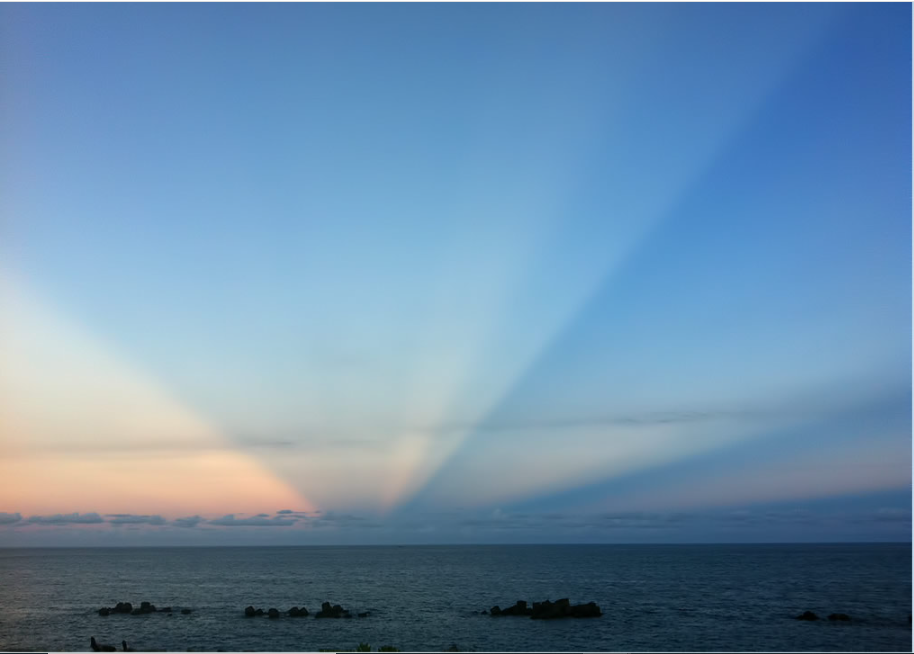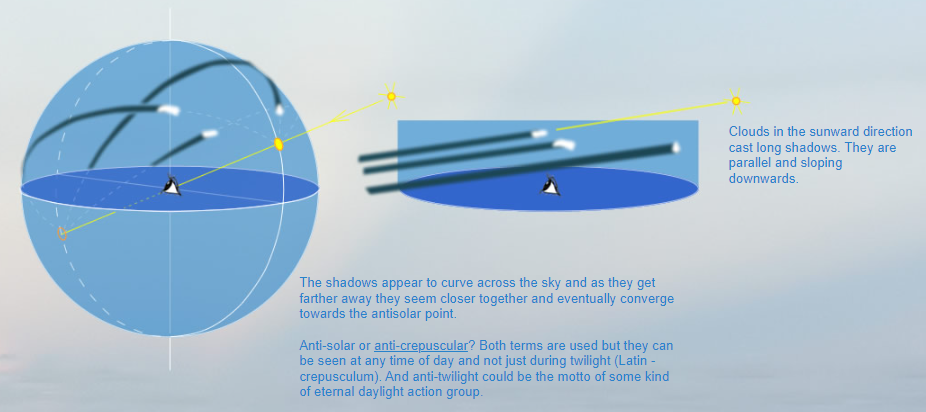OPOD - Antisolar or anticrepuscular rays
OPOD - Antisolar or Anticrepuscular Rays: A Phenomenon of Illuminated Shadows
Have you ever witnessed the captivating sight of shadows seemingly curving across the sky, gradually converging towards a distant point? If so, you may have encountered a mesmerizing atmospheric phenomenon known as antisolar or anticrepuscular rays. While these ethereal rays are often associated with twilight, they can be observed at any time of day, offering a fascinating display of nature's artistic prowess.
Antisolar rays, sometimes referred to as anti-crepuscular rays, derive their name from their apparent origin opposite to the sun's position. To witness this captivating spectacle, one must position themselves with the sun setting behind them, facing the opposite direction. The shadows cast by objects on the ground appear to extend towards the sky, creating an illusion of curving rays that grow closer together as they extend further into the distance.
Contrary to their name, antisolar rays are not exclusively visible during twilight hours. These radiant beams can be observed throughout the day, defying the notion that they are solely connected to crepuscular periods. In fact, their appearance during different times of day adds a sense of mystique and intrigue to their allure. Perhaps we could even consider them the emblem of an eternal daylight action group.
The mesmerizing convergence of antisolar rays towards a point opposite the sun, known as the antisolar point, is a result of perspective and the curvature of the Earth. As the shadows extend into the sky, they appear to come closer together due to the way our eyes perceive distance. This convergence effect creates a breathtaking visual effect, leaving onlookers in awe of nature's optical wonders.
It is important to note that while antisolar rays may share similarities with their twilight counterpart, anticrepuscular rays, they are not one and the same. Anticrepuscular rays are observed when the sun is below the horizon, casting its rays upwards through gaps in the clouds. These radiant beams extend across the sky in a direction opposite to the sun, much like their antisolar counterparts. However, unlike antisolar rays, anticrepuscular rays are exclusively visible during twilight hours.
To fully appreciate the magnificence of antisolar rays, it is helpful to understand the science behind their formation. When sunlight passes through gaps in clouds or other objects, it undergoes scattering and diffraction. This scattering causes the rays of light to spread out in various directions, creating the illusion of converging shadows. The phenomenon becomes particularly pronounced when atmospheric conditions favor the scattering of light particles, such as when there are dust particles or water droplets in the air.
In addition to their scientific explanation, antisolar rays hold a certain poetic beauty that captivates both scientists and nature enthusiasts alike. The convergence of shadows towards the antisolar point evokes a sense of wonder and awe, reminding us of the vastness and complexity of our natural world. As we gaze upon these illuminated shadows, we are reminded of the interconnectedness of all things and the intricate dance between light and darkness that shapes our perception of reality.
In conclusion, antisolar or anticrepuscular rays offer a mesmerizing spectacle that defies conventional notions of light and shadow. Whether witnessed during twilight or throughout the day, these radiant beams create a captivating display of nature's artistic prowess. As we marvel at the convergence of shadows towards the antisolar point, we are reminded of the intricate interplay between light and perspective that shapes our perception of the world around us. So, the next time you find yourself in a position to witness these ethereal rays, take a moment to immerse yourself in their beauty and ponder the mysteries they unveil.

Antisolar Rays
Nathan Richardson was at Hualien Taiwan.
He was facing east with the sun setting behind him in the west.
©Nathan Richardson, shown with permission.

The shadows appear to curve across the sky and as they get farther away they seem closer together and eventually converge towards the antisolar point.
Anti-solar or anti-crepuscular? Both terms are used but they can be seen at any time of day and not just during twilight (Latin - crepusculum). And anti-twilight could be the motto of some kind of eternal daylight action group.
Note: this article has been automatically converted from the old site and may not appear as intended. You can find the original article here.
Reference Atmospheric Optics
If you use any of the definitions, information, or data presented on Atmospheric Optics, please copy the link or reference below to properly credit us as the reference source. Thank you!
-
<a href="https://atoptics.co.uk/blog/opod-antisolar-or-anticrepuscular-rays/">OPOD - Antisolar or anticrepuscular rays</a>
-
"OPOD - Antisolar or anticrepuscular rays". Atmospheric Optics. Accessed on December 25, 2024. https://atoptics.co.uk/blog/opod-antisolar-or-anticrepuscular-rays/.
-
"OPOD - Antisolar or anticrepuscular rays". Atmospheric Optics, https://atoptics.co.uk/blog/opod-antisolar-or-anticrepuscular-rays/. Accessed 25 December, 2024
-
OPOD - Antisolar or anticrepuscular rays. Atmospheric Optics. Retrieved from https://atoptics.co.uk/blog/opod-antisolar-or-anticrepuscular-rays/.